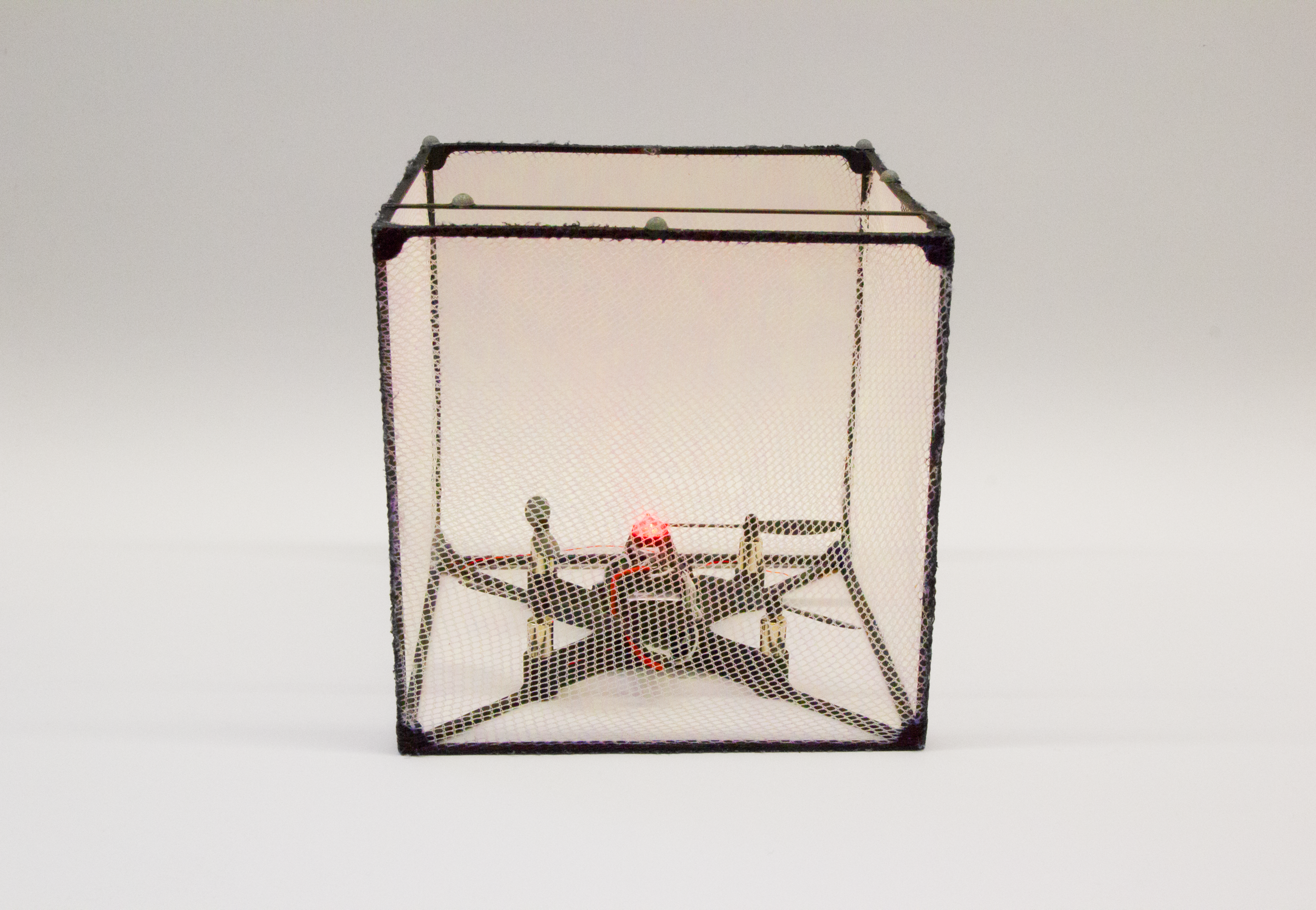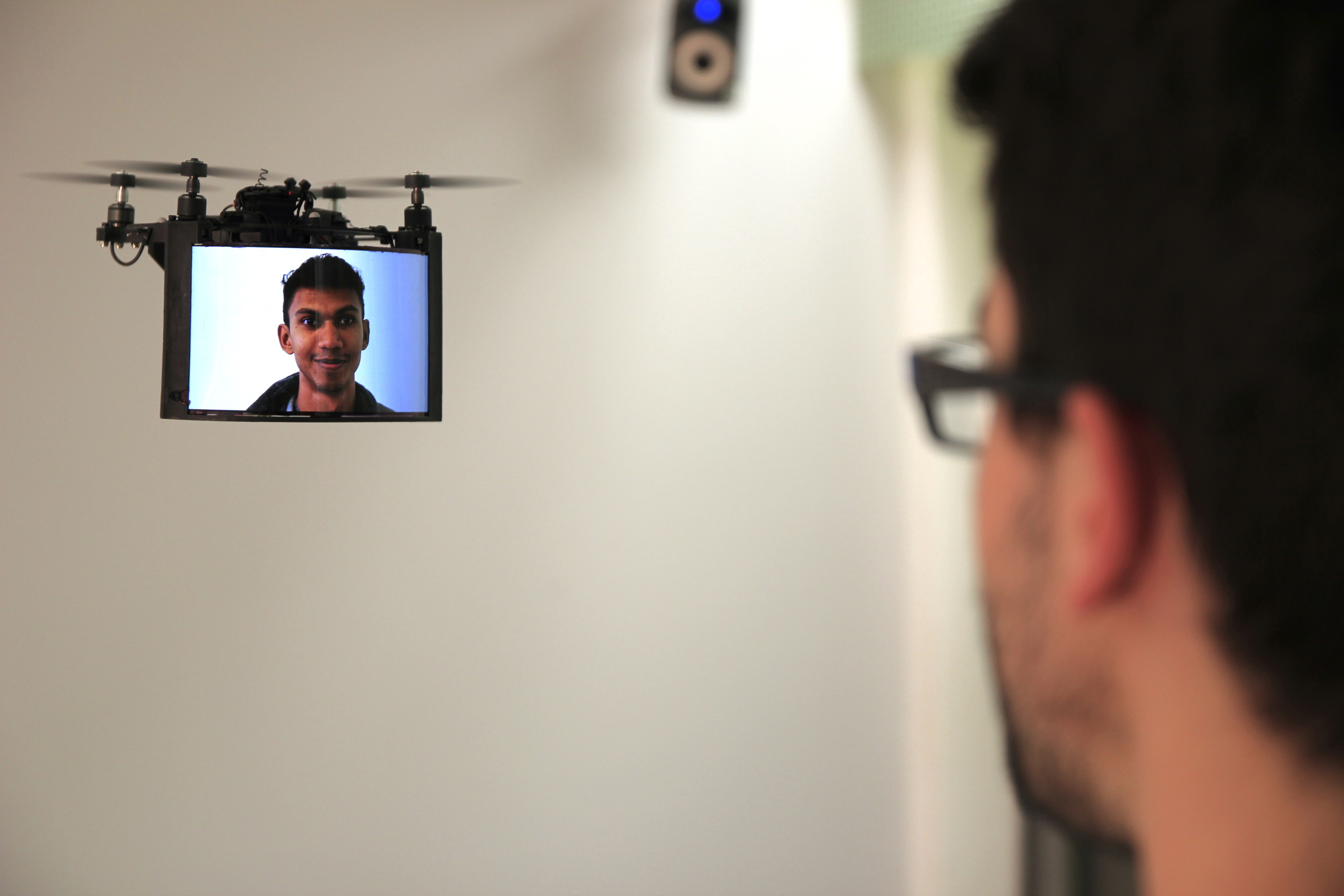Queen’s University’s Roel Vertegaal says self-levitating displays are a breakthrough in programmable matter, allowing physical interactions with mid-air virtual objects
KINGSTON, ON – An interactive swarm of flying 3D pixels (voxels) developed at Queen’s University’s Human Media Lab is set to revolutionize the way people interact with virtual reality. The system, called BitDrones, allows users to explore virtual 3D information by interacting with physical self-levitating building blocks.
Queen’s professor Roel Vertegaal and his students are unveiling the BitDrones system on Monday, Nov. 9 at the ACM Symposium on User Interface Software and Technology in Charlotte, North Carolina. BitDrones is the first step towards creating interactive self-levitating programmable matter – materials capable of changing their 3D shape in a programmable fashion – using swarms of nano quadcopters. The work highlights many possible applications for the new technology, including real-reality 3D modeling, gaming, molecular modeling, medical imaging, robotics and online information visualization.
“BitDrones brings flying programmable matter, such as featured in the futuristic Disney movie Big Hero 6, closer to reality,” says Dr. Vertegaal. “It is a first step towards allowing people to interact with virtual 3D objects as real physical objects.”
Dr. Vertegaal and his team at the Human Media Lab created three types of BitDrones, each representing self-levitating displays of distinct resolutions. “PixelDrones” are equipped with one LED and a small dot matrix display. “ShapeDrones” are augmented with a light-weight mesh and a 3D printed geometric frame, and serve as building blocks for complex 3D models. “DisplayDrones” are fitted with a curved flexible high resolution touchscreen, a forward-facing video camera and Android smartphone board. All three BitDrone types are equipped with reflective markers, allowing them to be individually tracked and positioned in real time via motion capture technology. The system also tracks the user’s hand motion and touch, allowing users to manipulate the voxels in space.
“We call this a Real Reality interface rather than a Virtual Reality interface. This is what distinguishes it from technologies such as Microsoft HoloLens and the Oculus Rift: you can actually touch these pixels, and see them without a headset,” says Dr. Vertegaal.
Dr. Vertegaal and his team demonstrate a number of applications for this technology. In one scenario, users physically explore a file folder by touching the folder’s associated PixelDrone. When the folder opens, its contents are shown by other PixelDrones flying in a horizontal wheel below it. Files in this wheel are browsed by physically swiping drones to the left or right.
Users are also able to manipulate ShapeDrones to serve as building blocks for a real-time 3D model. Finally, the BitDrone system allows for telepresence by letting remote users move around locally through a DisplayDrone with Skype. The DisplayDrone automatically tracks and replicates all of the remote user’s head movements, allowing a remote user to virtually inspect a location and making it easier for the local user to understand the remote user’s actions.
While their system currently only supports a dozen of comparatively large 2.5” - 5” sized drones, the team at the Human Media Lab are working to scale up their system to support thousands of drones. These future drones would measure no more than a half inch in size, allowing users to render more seamless, high resolution programmable matter.
High resolution photographs of BitDrones are available rights-free below.
References
Gomes, A., Rubens, C., Braley, S. and Vertegaal, R. BitDrones: Towards Using 3D Nanocopter Displays as Interactive Self-Levitating Programmable Matter. In Proceedings of ACM CHI’16 Conference on Human Factors in Computing Systems. ACM Press, 2016.
Rubens, C., Braley, S., Gomes, A., Goc, D., Zhang, X., Carrascal, J-P. and R. Vertegaal. BitDrones: Towards Self-Levitating Programmable Matter Via Interactive 3D Quadcopter Displays. In Proceedings of ACM UIST'15 User Interface Software and Technology Symposium, ACM Press, 2015.
Contact
Chris Armes
Communications Officer, Media Relations
613-533-6000 ext. 77513
chris.armes@queensu.ca
About Human Media Lab
The Human Media Lab (HML) at Queen’s University is one of Canada's premier Human-Computer Interaction (HCI) laboratories. Inventions include ubiquitous eye tracking sensors, eye tracking TVs and cellphones, PaperPhone, the world’s first flexible phone, PaperTab, the world’s first flexible iPad and TeleHuman, the world’s first pseudo-holographic teleconferencing system. HML is directed by Dr. Roel Vertegaal, Professor of HCI at Queen's University's School of Computing. Working with him are a number of graduate and undergraduate students with computing, design, psychology and engineering backgrounds.







